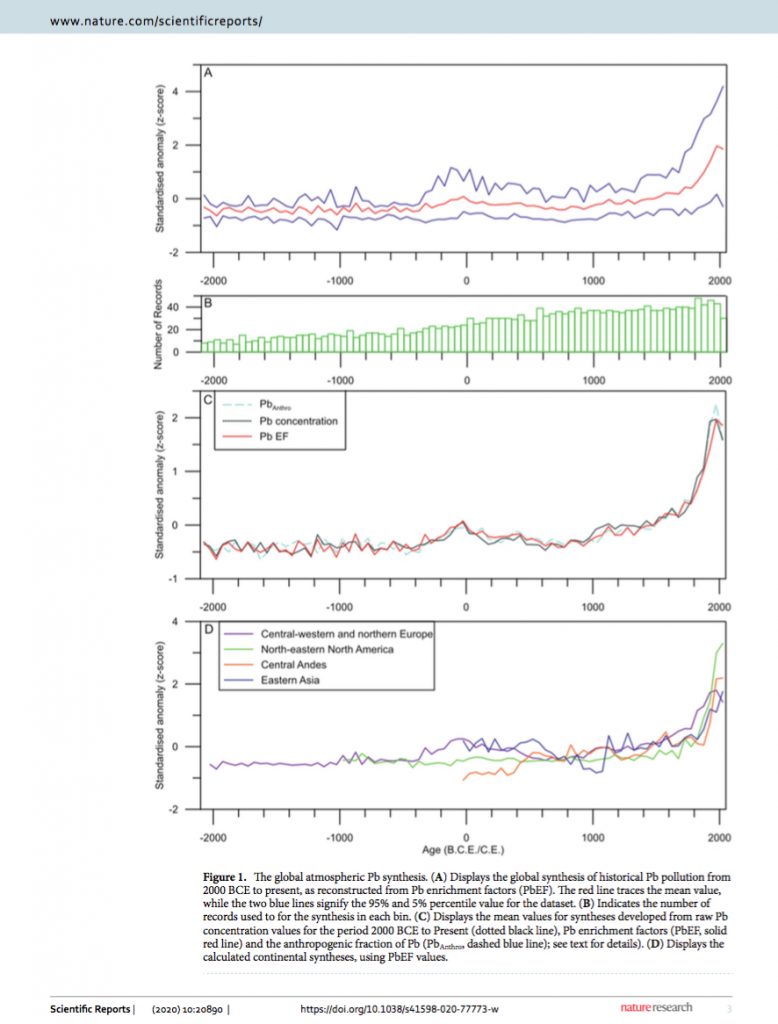A recent study has demonstrated that lead pollution has damaged the health of half the population of the USA. Lead can be inhaled or ingested. Between 30% and 50% of inhaled lead particles remain in the body, compared to 5-10% of lead particles that are ingested by adults. Lead is equally toxic however it enters the body, and it is especially dangerous for the growing bodies of children, which absorb far more ingested lead (40-50%). For more than a century, lead in paint and later in gasoline has exposed children to a lethal toxin in their homes and streets. (We shall look at lead in paint in another blog post.)
Every person alive today who was born before 1980 has suffered known or unknown effects from breathing the fumes of the gasoline additive tetraethyl lead (TEL). Millions have lived with or died from conditions without knowing that exposure to historical lead pollution may have contributed to them, including cognitive impairment, intellectual disability, and cardiovascular disease.
Despite knowing from soon after its introduction in the 1920s that burning leaded gasoline was deleterious to human health, the fuel additive, which boosts octane and reduces the likelihood of pre-ignition (“knocking“), was only fully banned for regular automobiles in the USA (and Germany) in 1996, following similar bans in other countries. It was only last year, in July 2021, that the last leaded gasoline was used in automobiles in Algeria. Moreover, leaded fuel is still used in aviation and in motorsports. Aviation (the use of “avgas”) emits more than half of the annual lead pollution in the USA, and children who live near airports suffer disproportionately. Although the most popular motor-racing organizations in the USA, NASCAR and ARCA, switched to unleaded fuels in 2007, it remains in common use.
A recent study has suggested that a single three-hour track race can release as much lead into the atmosphere as an average airport does in a year, causing atmospheric lead pollution to jump more than 20% in locations up to 50 miles from the track and persist for up to four weeks. The same study argues that the “social cost” of a burning a gallon of leaded racing fuel, which retails for $10-$20, is $110,000 per gram of TEL added (which varies, and is hard to identify precisely, but appears to be between 4 grams [medium, 110 octane] and 6 grams [high, 116 octane or more] per gallon).
The UK was a laggard in cleaning up its petrol, implementing a full ban only in 2000. Due to lead’s ability to persist in the environment, it has been shown that two decades later “lead deposited via gasoline combustion still contributes significantly to the lead burden in present-day London”. Likewise, in the USA, many studies in smaller and larger urban centers, from Appleton, WI, to Durham, NC, to New Orleans, LA, have shown the persistence of lead pollution in urban soils and argued for necessary remediation.
Cleaning up historical lead contamination, which is expensive and whose costs generally fall on communities and municipalities rather than state and national governments, has rarely been a priority, and therefore historical lead contamination remains a feature of urban environments. The same holds in rural settings.
The use of leaded fuel to run agricultural equipment was phased out less quickly than for regular automobiles in the USA. A presidential report published in 1986 recognized that a great deal of expensive farm equipment would have been damaged (“valve-seat recession“) if run on unleaded fuel. A shift to diesel-powered equipment — diesel was never leaded — took off at that time, but it has not been without significant health consequences for farmers. A further shift to electrification may be slower still because of the high power-to-weight ratio required to run of heavy farm equipment.
Lead from historical pollution remains a minor threat to our soil and food supply. Furthermore, lead (and other heavy metals), which was present in widely used commercial fertilizers, is now less of a problem. However, one must imagine that crops grown near sources of lead pollution, which today include airports and racetracks, remain problematic. Lead fixes in the top 2-5 cm of soil, but regular cultivation will drive it lower into the soil. Unfortunately, this is the root zone for many crops. Lead is drawn from the soil into these crops, and hence is ingested when eaten. There is more to do, therefore, but also an increasing recognition that it must be done even where local resources are inadequate.
Despite the foregoing gloom, there has been amazing progress in removing lead from urban and rural contexts, improving the health prospects of today’s children. Today, children ingest far less lead in their food even as they inhale far less than their parents and grandparents did as children. If lead in water and paint remain issues, modern governments have the knowledge and capacity to regulate and legislate necessary change. University and commercial researchers, large corporations and small businesses have embraced that change and taken it forward through innovation and investment. There are, of course, still local, regional, and national challenges, but the level of environmental lead pollution measured globally has fallen precipitously since reaching a global peak in the 1970s.

Historical levels of lead pollution are preserved in glaciers and revealed in extracted ice cores. These show that globally lead pollution reached increasingly higher peaks at various points over the past 2000 years. Alas, although falling rapidly, global lead pollution is still at historically high levels. Until the advent of leaded gasoline, each peak was associated with an increase in smelting and metallurgy. Conversely, the only return to something like a “background level” of atmospheric lead pollution has been associated with the demographic and economic catastrophe of the fourteenth century. Ancient Roman lead pollution reached its peak between 100 BC/BCE and CE/AD 100, which period marks the rise and fall of the Roman silver denarius.
Although recycling of lead was common, remediation of lead contamination was unknown in the pre-modern world. Hence, each additional peak in emissions added to environmental lead accumulation, which was far greater the closer one lived to a center for smelting. A good deal of evidence suggests that the Romans did not establish large settlements near mining/smelting facilities. However, recent research in Britain suggest this sensible rule was not universally observed. As yet to be published excavations near Charterhouse-on-Mendip in Somerset, one of the principal lead mining and smelting areas in Britannia, have uncovered a settlement of some size and wealth. It recently featured in a BBC archaeology show, Digging for Britain (season 9, episode 5).
Earlier field surveys at Charterhouse-on-Mendip had identified a substantial settlement, encompassing between 27 and 36 hectares (67-89 acres), which was continuously occupied until the fourth century CE, after which ceramic finds end. For some of the period of occupation it boasted an amphitheatre improvised from an existing earthwork. Clearly, this was not a peripheral mining colony occupied only by imperial slaves supervised by soldiers. It was, however, wholly reliant on imported food and fuel. Most significantly, there is no evidence for local agriculture to support the substantial settlement and related settlements at Priddy and Green Ore. This suggests clearly an awareness of the consequences of smelting on the local environment. [i]
Charterhouse-on-Mendip, where thin seams of galena (lead sulphide ore) exist near the surface of a limestone landscape, sits above a complex cave system. Mining is known at this site from pre-Roman times, and Roman slags contain up to 25% lead, more than a third of the original lead content before smelting. Whereas unprocessed galena is not soluble in water, roasted ore slag is more soluble and atmospheric fallout from smelting is highly soluble. Water permeating through the surface limestone into the caves has left clear indications of surface contamination in speleothems, mineral cave deposits formed from dripping water. One speleothem, in this case a stalagmite, suggests a peak in lead contaminants between CE 50 and 150, followed by a further and higher peak between CE 400 and 500, which falls away rapidly afterwards. This may relate to leaching from slag deposits after smelting activity had ended. However, it is also likely that mining and smelting continued in the Mendips for far longer than elsewhere, since it was known that these mines yielded the most silver. This is consistent with the continued but far lower levels of pollutants after CE 200 at bogs hundreds of miles to the north of the Mendips. There is no evidence for medieval reoccupation of the settlement at Charterhouse, which remained contaminated, but there was medieval mining activity. [ii]
If the most contaminated sites in Roman Britain were not used for arable or pastoral farming, still substantially increased levels of lead aerosols deposited across a broad region by precipitation will have affected bees and birds, fish and shellfish in polluted rivers and bays, cattle and sheep eating grass growing in contaminated soil. Lead entered the food chain and affected human health across northern Europe, hundreds of miles from smelting facilities. Consequently, many Roman children will have suffered in similar ways to modern children exposed to elevated levels of lead pollution and no efforts were made to remediate the environmental damage done by Roman-age smelting.
[i] M. Fradley, ‘The field archaeology of the Romano-British settlement at Charterhouse-on-Mendip’, Britannia 40 (2009), 99-122.
[ii] D. McFarlane t al., ‘A speleothem record of early British and Roman mining at Charterhouse, Mendip, England’, Archaeometry 56 (2013), 431-43.

